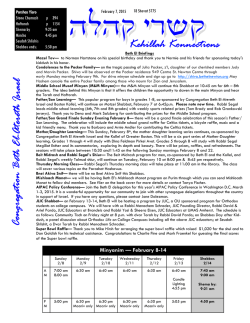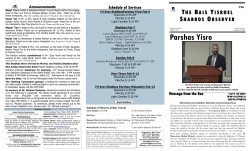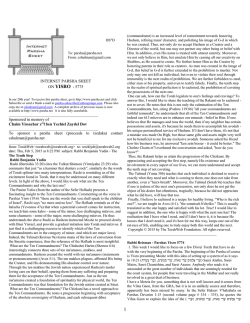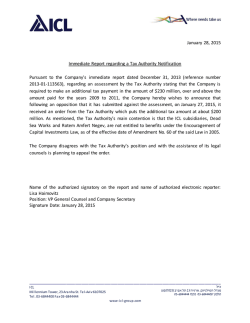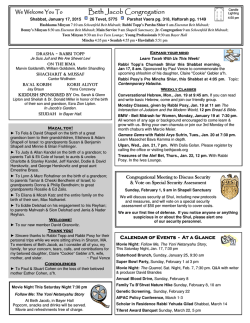
Kuntres Gimmel Tammuz 5774
באתי לגני תשל"ה Basi LeGani 5735 חלק ב Part Two www.simplychassidus.com About These Shiurim The shiurim are divided into three sections, each of which can be learned in approximately one hour. By learning one section per week, usually on Shabbos morning, participants can finish one ma’amar per month, with time to review the ma’amar on Shabbos Mevarchim. Simply Chassidus is translated by Simcha Kanter and is a project of Congregation Bnei Ruven in Chicago under the direction of Rabbi Boruch Hertz. Reviewed with Rabbi Fischel Oster in the zechus of refuah shleima for ר' ארי' יהודה בן שרה רבקה. Made possible by The ma’amar “Basi L’Gani 5735” from Sefer Hamaamorim Basi L'gani Vol. 1 is copyrighted by Kehot Publication Society, a division of Merkos L’inyonei Chinuch, and is reprinted here with permission. 3 ד"ה באתי לגני Also Available Online L’Cho Omar Libi 5720 🙧🙥 V’Haya Eikev Tishma’un 5727 🙧🙥 Gadol Yiyeh Kavod HaBayis 5722 🙧🙥 HaSam Nafsheinu B'Chaim 5718 🙧🙥 V'Atah Tetzaveh 5741 🙧🙥 Gal Einai 5737 🙧🙥 Ki Yishalcha Bincha 5738 🙧🙥 Matzah Zu 5749 🙧🙥 Omar Rabbi Oshia 5739 🙧🙥 Basi L'Gani 5734 🙧🙥 Basi L'Gani 5714 🙧🙥 And more! Sign up online to receive weekly translations as they are released. www.simplychassidus.com ה'תשל"ה,יו"ד שבט 4 Section Two So far in the ma’amar the Rebbe has made the following points: In the beginning of creation, Hashem’s presence was revealed in the physical world. When Adam sinned by eating from the Tree of Knowledge, it started the concealment of Hashem’s presence in the physical world. This concealment continued to increase for the next six generations. When Avraham began to serve Hashem, the concealment started to decrease. This continued for six more generations, concluding with Moshe Rabbeinu. The concealment was completely reversed at the time of the Giving of the Torah and the building of the Mishkan. Since no Jew wants to be separated from Hashem, the only way that sin occurs is when someone is overcome with irrational behavior – ruach shtus or shtus d’klipah. Since teshuvah must be done in a way that counteracts the initial cause of the sin, an irrational commitment to kedusha (shtus d’kedusha) is necessary in order to repair the damage of shtus d’klipah. We see this principle reflected in the building of the Mishkan. Because the Mishkan was built in order to counteract the sins of the previous seven generations, the Mishkan’s walls were made of shittim wood, which is related to the word “shtus.” This behavior is also referred to in Tehillim. Dovid HaMelech says that “[because] I was as an animal [who doesn’t possess logic] with You, [therefore] I was constantly with You.” Because he committed himself to Hashem in a way that was beyond the limits of his own logic, he was able to connect to Hashem’s unlimited essence (“with You”). ד"ה באתי לגני 5 Davening influences our overall service of Hashem by elevating our thoughts, speech, and actions to their ultimate purpose. Since the ultimate goal of a person’s service of Hashem is to be “constantly with You” (through shtus d’kedusha), and davening brings the Jew’s service of Hashem to its ultimate expression, we must find the goal of “constantly with You” (and shtus d’kedusha) expressed in davening. We see that the Alter Rebbe expressed this desire to connect to Hashem’s unlimited essence during davening when he would say, “I don’t want Your Gan Eden, I don’t want Your Olam HaBa, I just want You!” This is the ultimate expression of love for Hashem and reflects the possuk, “with You (when I’m connected to Your essence) I didn’t desire anything on earth!” After introducing the principle of shtus d’kedusha at the beginning of the fifth chapter, the Frierdiker Rebbe brings a lengthy quote from the Gemara in Kesubos that explains how certain sages would dance with shtus d’kedusha at a chassuna. Seemingly, the Frierdiker Rebbe’s intent in providing this quote was to reference the fact that the approach of shtus d’kedusha is mentioned in the Gemara as a way of serving Hashem. However, if this is the case, why did the Frierdiker Rebbe quote the entire passage from the Gemara which seemingly contains many irrelevant details? In this section, the Rebbe will explain that the Frierdiker Rebbe referenced the details of this section in the Gemara in order to explain the details of how one can behave with shtus d’kedusha. ה'תשל"ה,יו"ד שבט 6 Earlier in the ma’amar, the Rebbe said that the walls made of shittim wood surrounded the entire Mishkan because they were a fundamental aspect of the Mishkan’s construction. The Rebbe now builds on this approach by analyzing the role of the walls within the Mishkan’s construction. דהנה עשיית המשכן מעצי שטים היתה,ד) ונקודת הביאור בזה דהיינו הקירות שהקיפו את כל,באופן שעצי שטים הו"ע של מקיף ואילו בתוך המשכן נעשו כל עניני העבודה שכללותם,עניני המשכן שעבודה, עבודת התמידין ועבודת המוספין,הו"ע עבודת הקרבנות בכמה פרטים ופרטי,זו היתה צריכה להיות בטעם ודעת דוקא שטים מלשון, אלא שכל ענינים אלו היו מוקפים בעצי שטים.פרטים ומקיף זה, שהו"ע שטות דקדושה שלמעלה מטעם ודעת,שטות .השפיע ופעל בכל עניני העבודה שבמשכן These wooden beams were not the main focus of the Mishkan’s daily function. Rather, the main focus was korbanos (sacrifices), and the bringing of korbanos was surrounded by the beams made of shittim wood. Just like our overall service of Hashem (revealing His presence in the physical world) is represented by the Mishkan, this structural arrangement also reflects the way that our service should be performed. The act of bringing korbanos involves many complex procedures and intricate details. Clearly, an illogical approach of shtus d’kedusha would not be sufficient in order to perform this service correctly. However, everything that was done in the Mishkan was surrounded (influenced) by the walls made of shittim wood – shtus d’kedusha. The Rebbe explains the parallel in a Jew’s service of Hashem: בענין התפלה (שבזה מתבטא ענין השטות,וכן הוא גם בהנמשל , שזהו מ"ש ואני בער ולא אדע גו' שעי"ז אני תמיד עמך,דקדושה ד"ה באתי לגני 7 על כלi שישנו הכלל והנקודה שהוא מקיף ומשפיע,)כנ"ל ס"ב .הפרטים שבענין התפלה Just like the Mishkan was primarily focused on the logical details of the korbanos but surrounded by beams made of shittim wood, a Jew’s service of Hashem needs to be logical and detail-oriented to ensure it is correct while being influenced by the approach of shtus d’kedusha. This is also true regarding davening; a Jew‘s love for Hashem, which is a simple and pure yearning like an animal (who has no intellect), needs to affect the details of his davening as well. The Rebbe explains this aspect of davening in greater detail: ' דהנה נת"ל שעיקר ענין התפלה הוא כהלשון שהי,והענין בזה מי לי בשמים ועמך לא חפצתי,נשמע מרבינו הזקן בעת דביקותו , בשם כל ישראל,1 נעים זמירות ישראל, כפי שאומר דוד המלך,בארץ וכפי שמקדים בכתוב שהתנאי והדרך,ולפנ"ז כתיב ואני תמיד עמך הרי דוקא בתפלה, ומ"מ.'לבוא לזה הוא עי"ז שאני בער ולא אדע גו . דהיינו פרטי הדברים דוקא,צ"ל בקשת צרכיו On one hand, the main goal of davening is to connect to Hashem’s essence. As explained in the previous section, Dovid HaMelech explained this process in Tehillim: Because I was “[as] an animal [who doesn’t have intellect] with You,” therefore I was able to be “constantly with You (connected to Your essence).” This connection leads to the love (mentioned a few pesukim later) of “whom do I have in heaven, with You I desired nothing on earth!” . א, שמואל־ב כג1 יו"ד שבט ,ה'תשל"ה 8 On the other hand, the majority of davening is made up of requests for one’s detailed personal needs. This seems to be a contradiction to “with You I don’t desire anything on earth,” which implies that a !connection to Hashem’s essence would negate one’s personal needs The Rebbe provides a basis for the fact that davening is about asking for one’s personal needs (and parenthetically explains the basis for the Rambam’s opinion regarding the obligation to daven): דהנה ידועה מחלוקת הפוסקים אם תפלה היא מצות עשה מן התורה ,כמבואר בארוכה בנו"כ הרמב"ם בריש הלכות תפלה ,2שכתב מצות עשה להתפלל בכל יום .ומצינו בזה מחלוקת בין הבבלי לירושלמי ,שבבבלי איתא בנוגע לרשב"י וחבריו שתורתן אומנתן, שמפסיקין לק"ש ואין מפסיקין לתפלה ,3והיינו לפי שק"ש דאורייתא ותפלה דרבנן ,אמנם בירושלמי 4הובאו בזה ב' דעות ,דעת ר' אחא, שק"ש דבר תורה ותפלה אינה דבר תורה ,ודעת ר' בא ,שק"ש זמנה קבוע ותפלה אין זמנה קבוע .ומזה מוכח שלדעה זו התפלה עצמה היא מן התורה .וי"ל שזהו היסוד לדברי הרמב"ם שתפלה היא מ"ע מן התורה .ואע"פ שבבלי וירושלמי הלכה כבבלי ,5מ"מ ,ישנם ראיות גם מכ"מ בבבלי שתפלה דאורייתא ,6ורק נוסח התפלה וזמני התפלה הם מדרבנן.7 2ראה רמב"ן בהשגות לספר המצוות להרמב"ם מ"ע ה ובנ"כ שם .סמ"ק מצוה יב .ספר זהר הרקיע להרשב"ץ אות יב. 3שבת יא ,א ובפרש"י שם. 4ברכות פ"א ה"ב .שבת פ"א ה"ב. 5רי"ף סוף עירובין .וראה אנציקלופדי' תלמודית (כרך ט) ערך הלכה ע' רנ ואילך .וש"נ. 6ראה פס"ד להצ"צ חידושים על הרמב"ם שמ ,ג ואילך. 7ראה מגלת אסתר לספר המצוות שם .וראה גם אג"ק אדה"ז ע' לג ואילך .סהמ"צ להצ"צ קטו ,א .מכתב י"א ניסן תשט"ז (אג"ק חי"ב ע' תיב). ד"ה באתי לגני 9 In the Rambam’s Sefer HaMitzvos, the Rambam states that the mitzvah to daven every day is one of the Torah’s 248 positive mitzvos. The commentaries on the Rambam argue this point, and some of them claim that davening is only a rabbinic requirement. This difference of opinion originates in a disagreement between the Talmud Bavli (Babylonian Talmud) and the Talmud Yerushalmi (Jerusalem Talmud). The Talmud Bavli states that Rabbi Shimon bar Yochai and his colleagues would interrupt their learning to say shema [at its proper time] but would not stop in order to daven because “Torah was their occupation.” The reason they would give priority to shema over davening is because shema is a biblical mitzvah while davening is a rabbinic one. Since learning Torah is a biblical mitzvah, they would not stop learning in order to daven, which is rabbinic. However, the Talmud Yerushalmi provides two opinions (Rebbi Acha and Rebbi Ba) for why Rabbi Shimon bar Yochai and his colleagues would not stop learning in order to recite shema. Rebbi Acha, like the Talmud Bavli, is of the opinion that davening is a rabbinic mitzvah. However, Rebbi Ba is of the opinion that davening is a biblical mitzvah and provides a different explanation for why they would not stop learning Torah in order to daven. He states that there is a fixed time for saying shema (it must be said during certain hours of the night and the morning), but there is not a fixed time for davening. Since they were already learning Torah (which has no fixed time), there was no reason for them to interrupt that mitzvah with another mitzvah (davening) which also has no fixed time. This opinion of Rabbi Bo is the Rambam’s basis for his ruling in Sefer HaMitzvos that davening is one of the 248 positive commandments from the Torah. (Even though there is a general principle that whenever there is a disagreement between the Talmud Bavli and the Talmud Yerushalmi the Halacha follows the Talmud Bavli, there are ה'תשל"ה,יו"ד שבט 10 other places within the Talmud Bavli that support the claim that davening is a Torah commandment, while only the times and structure of davening are rabbinic.) The fact that davening is a biblical mitzvah is also supported by the Zohar: 'וגדולה מזו מצינו ברעיא מהימנא (שהוא ספר המצוות שבזהר) פ פקודא חד סר [איהי] איתקריאת צלותא דשחרית מנחה,8פנחס שלשיטת הזהר לא רק התפלה עצמה אלא גם, שמזה משמע,ערבית 9 וזהו גם מה שמצינו בירושלמי ברכות.זמני התפלה הם מן התורה .שאחיתופל הי' מתפלל שלש תפלות בכל יום When counting the biblical commandments, the Zohar says, “The eleventh mitzvah is to daven shachris, mincha, and ma’ariv.” Since the Zohar lists all three times for davening, this implies that the Zohar holds that the times for davening are also biblical mitzvos. This is supported by the Talmud Yerushalmi in mesechta Brachos which states that Achitofel, who lived before the rabbinic decrees were enacted, would daven three times every day. The Rebbe returns to the point that davening is about expressing one’s personal needs: הרי גם לפי הדעות שזמני התפלה ונוסח התפלה אינם מן,ובכל אופן ועיקרה הוא כלשון, הרי התפלה עצמה חיובה מן התורה,התורה .הרמב"ם שיהא אדם שואל צרכיו שהוא צריך להם בבקשה ותחנה Regardless of the source for the times and structure of davening, davening is a biblical commandment and is fundamentally about asking for one’s personal needs. . א, זח"ג רנז8 . פ"ד ה"ד9 ד"ה באתי לגני 11 The Tzemach Tzedek also explains the importance of asking for one’s personal needs during davening: ובפרט ע"פ ביאור הצ"צ בתחילת שורש מצות התפלה( 10לאחרי שמביא שיש מחלוקת הפוסקים אם תפלה מ"ע מדאורייתא או מדרבנן ,ורוב מוני המצוות העלו שמצות התפלה מדאורייתא היא בקשת צרכיו) ,שזהו משרשי האמונה לפי שעי"ז ידע ויבין שהשי"ת הוא לבדו המנהיג עולמו ומשגיח בכל פרטי בריותיו וכי לו לבדו היכולת להושיע. In the ma’amar “Shoresh mitzvas ha’tefillah” the Tzemach Tzedek explains that davening for one’s needs reinforces one’s faith in Hashem. When one asks Hashem for what he needs, it reminds him that Hashem has exclusive control over the entire world and Hashem is the only one that has the ability to provide his needs. We also see this point expressed in the tefillah of Shlomo HaMelech regarding the Bais HaMikdash: וכן מוכח גם מתפלת שלמה בנוגע לביהמ"ק ,כל תפלה כל תחנה אשר תהי' לכל האדם (כאשר יהי' אצלו ענין בלתי רצוי ,כפי שמפרט לפנ"ז כו"כ פרטים) ,ופרש כפיו אל הבית הזה ,ואתה תשמע גו' ונתת לאיש וגו' ,11וגם אל הנכרי גו' אתה תשמע גו' ועשית ככל אשר יקרא אליך הנכרי ,12ועאכו"כ בנוגע לאיש ישראל (אלא שגבי נכרי כתיב ככל אשר יקרא אליך הנכרי ,מצד קידוש השם ,שלא יהא קורא תגר כו' ,משא"כ ישראל כתיב ונתת לאיש ככל דרכיו גו' .)13ונמצא ,שענינו של ביהמ"ק שבו צריכה להיות בקשת צרכיו ,דהיינו צרכים פרטיים דוקא. 10סהמ"צ להצ"צ שם. 11מלכים־א ח ,לח־ט. 12שם ,מא־ג. 13פרש"י שם. ה'תשל"ה,יו"ד שבט 12 Shlomo HaMelech says, “Any prayer, any supplication, which will be (made) by any Jew, (or) by all Your people Israel… and [the person davening will] spread forth his hands toward this house (the Bais HaMikdash). And You shall hear in heaven… and give to every Jew according to his ways (only if he deserves it)… and [also] do according to all that the non-Jew calls You for (even if he doesn’t deserve it, because he will lose faith in You if he doesn’t receive his request).” From this, we see that davening is about asking for one’s personal needs, and we see that requesting one’s personal needs is connected to the Bais HaMikdash (and the Mishkan, which is like the Bais HaMikdash). Just like the main service in the Mishkan was the technical details of the service of korbanos, so too the main service of davening is asking for life’s “technical details” - one’s personal needs. Even though the main service of the Mishkan was the korbanos, the Mishkan was surrounded by shittim wood: , הנה ענין התפלה הוא באופן דעמך לא חפצתי בארץ,וביחד עם זה ואפילו לא צרכים,שבמצב כזה לא שייך אצלו צרכים גשמיים איך וויל מער ניט ַאז, כי אם, ואפילו לא דרגא הכי עליונה,רוחניים .דיך ַאליין Just like the main service of the Mishkan needed to be surrounded by shittim wood, the “main” service of davening (asking for one’s personal needs) needs to be “surrounded” (impacted by) shtus d’kedusha. This means that while a Jew needs to daven for his personal needs, this davening needs to result in a feeling of “with You, I don’t desire anything on the earth.” How is it possible for these two opposite feelings – asking for one’s needs and not wanting anything besides Hashem’s essence – to coexist? 13 ד"ה באתי לגני שכללות ענין התפלה הוא באופן דסולם מוצב ארצה,וביאור הענין שע"י התפלה מתעלה איש ישראל, היינו,וראשו מגיע השמימה אבל באופן שיש בזה גם כל,' עד לבחי' ועמך לא חפצתי גו,השמימה ריבוי הכמות בתפלה הוא בנוגע לענינים, ואדרבה,עניניו הפרטיים .הפרטיים As explained earlier in the ma’amar, Davening is described as a “ סולם ( ”מוצב ארצה וראשו מגיע השמימהa ladder set up on the ground and its top reached to heaven) because it elevates (up the “ladder”) all of a person’s thoughts, speech, and actions until they reach “( ”השמימהto heaven), the highest level of G-dliness. We see from this description that davening is a “ladder” which is able to connect the lowly details of the physical world (ארצה ground) to the highest levels that a Jew מוצב, standing on the can reach (השמימה, to heaven). This means that it is possible for a Jew to daven for his physical and spiritual needs (which make up the majority of davening) without desiring them for his own sake – he only wants Hashem’s essence. Additionally, when a Jew davens with the focus of “with You I don’t desire anything on earth” it also impacts his behavior after davening: וענין זה נמשך ופועל גם לאחרי הדביקות שבעבודת התפלה (כדיוק בכל,)הלשון בנוגע לרבינו הזקן שכך הי' נשמע הלשון בדביקותו דאף שאמרו,פרטי העבודה ואופן ההנהגה במשך כל היום כולו הרי על זה אומרים הלואי, הלואי שיתפלל אדם כל היום כולו14רז"ל והיינו לפי שצריך להיות גם עבודת כל היום באופן דכל יומא,'כו אלא שכל זה צריך להיות חדור עם ההכנה,15'ויומא עביד עבידתי .' שזהו"ע דעמך לא חפצתי גו,וההקדמה והסך־הכל דעבודת התפלה . ירושלמי שם פ"א ה"ב. א, ברכות כא14 . ב, ראה זהר ח"ג צד15 ה'תשל"ה,יו"ד שבט 14 Even though the Gemara says “It would be great if a Jew could daven all day,” this statement expresses the way a Jew should feel and not the way he should actually live. In reality, a Jew needs to spend most of his day involved with refining the physical world to create a dirah b’tachtonim. When he davens in the proper way and reaches the state of “with You I don’t desire anything on earth,” this allows him to properly focus on his mundane daily tasks with the proper intention. In summary, because davening is a “ladder” that connects the “ground” to the “heaven,” davening is able to connect the highest levels of connection to Hashem (“with You”) to everyday mundane needs and activities. This reflects the structure of the Mishkan, whose operation was focused on korbanos (corresponding to mundane activities) but was surrounded with (impacted by) shittim wood (representing shtus d’kedusha, a connection to Hashem which is beyond all limitations). The Rebbe connects this to a teaching of the Ba’al Shem Tov: שזהו חסד, ובכ"מ16ה) וזהו גם מ"ש הבעש"ט בצוואת הריב"ש שלפי דרך הטבע הי' לו למות,גדול מהשי"ת שאדם חי אחר התפלה . כי נתן כחו בהתפלה כל כך מכח הכוונות הגדולות שהוא מכוין,'כו In Tzava’as HaRivash, the Ba’al Shem Tov teaches that “a person only survives davening because of the great kindness of Hashem. If it were up to nature, a person would pass away after davening with all of his energy and concentration.” שאף שמדובר אודות התפלה כפי שנקבעה בנוסח שלנו שיש,והיינו צריכה להיות התפלה באופן שבכל, מ"מ,בה י"ח ברכות פרטיות ועד,'הענינם הפרטיים ניכר ונרגש (עס הערט זיך) ענין הכליון כו .שזהו חסד גדול מהשי"ת שלא נעשה ענין הכליון כפשוטו . סמ"ב. סל"ה16 ד"ה באתי לגני 15 This teaching of the Ba’al Shem Tov was said in reference to the structured format of davening that is printed in the siddur, which has eighteen (actually, nineteen) brachos that speak about very specific things. Nevertheless, a Jew needs to infuse this structured davening with a yearning for Hashem’s essence that is so intense that it could actually cause k’los hanefesh - his soul to leave his body. This concept can also be seen in a teaching of the Maggid of Mezritch: העושה18 בפירוש דברי הגמרא17ועד"ז מבואר בתורת הרב המגיד תפלתו פי' התדבקות בהקב"ה,תפלתו עגולה סכנה ואין בה מצוה ,) שענינה התדבקות בהקב"ה,(היינו שמפרש תפלתו מלשון תפלה פעמים הוא, פעמים שהוא דבוק בהקב"ה ופעמים אינו,עגולה אזי אינה, ואינו תמידות, כדבר העגול,למעלה ולפעמים הוא למטה שכאשר התפלה, והיינו. מצוה הוא לשון התחברות כמו צוותא,מצוה הרי זה מורה שאינו במעמד ומצב של,היא באופן שיש בה שינויים . שאז לא הי' שייך בזה ענין של שינויים,צוותא והתחברות The Gemara in Megilla says, “Someone who makes his head tefillin round is placing himself in danger [because it can pierce his skull] and is not performing a mitzvah [because round tefillin are not kosher].” The Maggid divides this statement into four parts: 1. “( ”תפלתוhis head tefillin) – this can also be read as “his davening.” 2. “( ”עגולהagula, round) – this refers to something which goes in cycles and changes periodically. Like a spinning wheel, a given point on the wheel is sometimes on the top and sometimes on the bottom. . תעט. אור תורה סימן תז17 . ב, מגילה כד18 ה'תשל"ה,יו"ד שבט 16 3. “( ”סכנהsakana, danger) – the Rebbe will explain this in the following section. 4. “מצוה ”ואין בה (it is not a mitzvah) – the word “ ”מצוהis related to the word “( ”צוותאAramaic for “connection”). Based on these interpretations, the Gemara can be read as follows: If a Jew’s davening ( )תפלתוis subject to changes ( – )עגולהsometimes he is connected to Hashem and sometimes he isn’t – this isn’t a true connection to Hashem’s essence (מצוה )ואין בה. If he would truly be connected to Hashem’s essence, which is beyond all limitation and never changes, his connection would be constant and never change. [Editor’s note: This is very similar to how the Rebbe explained the teaching of the Ba’al Shem Tov on the possuk “לנגדי תמיד '”שויתי הוי (I have placed Hashem before me constantly) in the other ma’amar which explains this chapter, Basi L’Gani 5715.] The Rebbe explains why this can be called “dangerous”: והיינו, כפי' רש"י שלא תכנס בראשו, שזהו"ע של סכנה,ויתירה מזה , הרי זה סכנה שלא ירצץ מוחו,19שכאשר נופל בעת אמירת תחנון שנפילת אפים הו"ע הירידה למטה מהקדושה לברר,והענין בזה ולכן אם תפלתו,)20בירורים כו' (כמבואר בארוכה בכתבי האריז"ל יש סכנה,היא באופן שאין בה ח"ו צוותא והתחברות למעלה .'בהתעסקותו בעבודת הבירורים כו Rashi explains that the rounded edge of the tefillin is more likely to pierce someone’s skull than the large flat edge of the tefillin we use . פירוש הר"ח שם19 ' מאמרי אדה"ז תקס"ה ח"א ע. ג, וראה לקו"ת פ' ראה לב. פרי עץ חיים שער נפילת אפים20 .עה ואילך 17 ד"ה באתי לגני (all the force will be focused on the single point at the edge of the curve rather than distributed across the flat surface). Rabbeinu Chananel explains that this could happen during nefilas apayim, the time when one puts his head down during tachnun. Chassidus explains that nefilas apayim represents a Jew’s descent into the mundane world to release the G-dly potential that is concealed within physical things by using them to serve Hashem. If someone has an inconsistent connection to Hashem (their davening is “round”), their involvement in the physical world is “dangerous” because they may come to use the physical world for their own selfish goals rather than the service of Hashem. This teaching of the Maggid brings out the two extremes of davening explained above (that a Jew requests his personal needs but still reaches a state of “with You I don’t want anything on the earth”): שהתפלה צ"ל באופן של, היינו,ומזה מובן ב' הקצוות שבתפלה אלא, שאינה עגולה, היינו,)דביקות והתחברות (שזהו גם ענין הכליון כשם שהקב"ה עצמו (שעמך לא חפצתי) הוא,למעלה משינויים הרי זה נמשך בהשינויים, וביחד עם זה,למעלה מכל שינויים ולכן גם בהתפלה מתחיל,שמוכרחים להיות בעבודה שבמשך היום עד, שהו"ע עבודת הבירורים, שיש בה גם אמירת תחנון,השרש להם .לבירור התחתון שנמצא למטה מענין ומקום הקדושה On one hand, davening needs to connect a Jew to Hashem’s essence, which results in a feeling of “with You I don’t want anything on earth”. When the Jew connects to Hashem’s unchanging essence, his connection to Hashem is consistent and not “round” (inconsistent). On the other hand, the Jew needs to realize that the devaykus of this unchanging connection must be applied to the changing situations of everyday life. In order to accomplish this, davening includes tachnun (with nefilas apayim). Tachnun applies the intense connection of shimone esrei to ה'תשל"ה,יו"ד שבט 18 doing teshuvah for our sins (which are outside the realm of holiness). By dealing with something “outside the realm of holiness” during davening, the Jew is prepared to apply the intense connection of shimone esrei to our service of Hashem in his everyday life (outside the realm of holiness). The Rebbe now returns to the question regarding why the Frierdiker Rebbe quoted the Gemara from Kesubos with all the seemingly irrelevant details: ו) והנה כשם שנת"ל בעבודת התפלה שיש בה כו"כ ברכות וכו"כ כן, אלא שכל ענינים אלו הם באופן דעמך לא חפצתי,בקשות צרכיו ועל זה מביא בהמאמר הש"ס דכתובות.הוא גם בכללות העבודה .אודות ענין הריקוד בבד של הדס Just like davening combines the two opposites of “with You, I don’t want anything on earth” and requesting one’s personal needs, a Jew’s overall service of Hashem also combines these two opposites. As the Rebbe will soon explain, the Frierdiker Rebbe quoted the details from the Gemara in Kesubos in order to explain these two aspects within a Jew’s overall service of Hashem. First, the Rebbe explains the significance of dancing with hadassim (myrtle branches): בענין מרקד23 כפי שמבאר אדמו"ר האמצעי בסידור,והענין בזה שענין זה מורה על כללות, והיינו, שג' הדסים הן ג' קוין,אתלת ויתירה.21עבודת האדם בשלשה העמודים שעליהם העולם עומד וגם בהמשך,22 כמבואר בדרושי ולקחתם לכם לאדמו"ר הצ"צ,מזה . אבות פ"א מ"ב21 . ראה אוה"ת ויקהל ע' ב'צח22 19 ד"ה באתי לגני בביאור ענין,)24 (מיוסד על כתבי האריז"ל23וככה לאדמו"ר מהר"ש שענינו של הדס הוא באופן,ד' המינים שרומזים על האחדות שכאשר ישנם ג' הדסים, ומזה מובן,25דתלתא (ג' עלים) בחד קינא ) שכל אחד מהם הוא באופן26(כמו בלולב ומיניו שצ"ל ג' הדסים הרי זה מורה על תכלית השלימות בענין,דתלתא בחד קינא . אבל הם באופן של התכללות, שישנם ריבוי פרטים,ההתכללות The Mittler Rebbe explains that “dancing with three hadassim” represents what the Mishna calls “the three pillars upon which the world stands” – learning Torah, the service of Hashem (davening), and deeds of kindness (which refers to mitzvos). Gathering three hadassim together represents unifying these three areas as one. Furthermore, the Tzemach Tzedek and Rebbe Maharash explain that each of the three hadas branches represents unity because the leaves hadassim grow in groups of three. The combination of three hadassim, each of which have leaves in groups of three, represents the ultimate unity of all areas of service of Hashem. This parallels the concept of how all the detailed personal requests of davening and the details of everyday life need to be united in the feeling of “with You I don’t desire anything on earth.” The Rebbe continues to explain how the deepest connection to Gdliness is able to unite all the various details of serving Hashem in everyday life based on his father’s notes on Tanya: . פרק פז23 . ראה פרי עץ חיים שער הלולב פ"ג24 . ב, סוכה לב25 .) ב, ראה גם תקו"ז תכ"א (נו26 ה'תשל"ה,יו"ד שבט 20 לאגרת הקודש27ויש להוסיף בזה ע"פ מ"ש אאמו"ר בהגהותיו , שמבאר תחילה הענין דשבק חיים לכל חי,בקשר ליום הילולא שהו"ע נעלה יותר,29ואח"כ מוסיף שישנו גם הענין דאור זרוע לצדיק ,מענין שבק חיים לכל חי 28 In Iggeres HaKodesh 27, the Alter Rebbe quotes a phrase often used by the sages to describe the passing of a tzadik, “חי (He has left life for all the living). ”שבק חיים לכל The Alter Rebbe continues to explain that the life of a tzadik is much more than physical life: the life of a tzadik is faith, awe, and love of Hashem. Therefore, the phrase, “He has left life for all the living,” means that the disciples of the tzadik continue to live with the tzadik’s “life” – faith, love, and fear – to an even greater degree after his passing. Because this type of energy is limited (pnimius) it can be received by the disciple’s limited capabilities in a way that will become part of him and impact his ability to serve Hashem. The Alter Rebbe then explains a second level of spiritual influence that the tzadik continues to have after his passing. referred to as “לצדיק ”אור זרוע This level is (light planted for the tzadik), and awakens within his disciples’ hearts “thoughts of teshuvah and good deeds.” Since this level of influence is higher than “he has left life for all the living,” it cannot be received by the disciples in a way that becomes a part of their everyday behavior (pnimius). Instead, it affects them in a way of makif and can suddenly inspire teshuvah and good deeds even without intellectual or emotional preparation. . וראה גם שם ע' כב. לקוטי לוי יצחק הערות לתניא ע' נ27 . סי' ז"ך28 . יא, תהלים צז29 21 ד"ה באתי לגני The Rebbe’s father, Rabbi Levi Yitzchok Schneerson, explains these two levels and compares them to the kabbalistic significance of the lulav and the hadas: והדס, שלולב בגימטריא חיים30ומביא מ"ש בכתבי האריז"ל , ואור בגימטריא ג"פ הדס,)בגימטריא חיים וא' יותר (עם הכולל , שענין אור זרוע לצדיק הוא למעלה מענין שבק חיים לכל חי,ונמצא ' וכמו ג,כי אור מספרו ג"פ חיים וא' יותר בכל או"א מהג"פ חיים שצדיק הוא יסוד, ומבאר שם.הדסים שהדס מספרו חיים וא' יותר שהם הג' בחי' חיים דאמונה יראה ואהבה,ומספרו ג"פ חיים שזהו מה, וכמו שביוסף יסוד נמשך מהג' אבות,המאירים ביסוד . היינו שהוא בן לכל הג' אבות,שיוסף מספרו ג"פ בן When explaining that the true life of the tzadik is love, fear, and faith in Hashem, the Alter Rebbe refers to various pesukim and writes, “Because a ‘tzadik lives with his faith,’ ‘fear of Hashem [leads to] life, and the ‘flashing and fiery sparks’ of his love [for Hashem, who is even greater] than life.” The Rebbe’s father comments on the word ‘tzadik’ and notes that “ ”צדיקhas the gematria (numerical value) of three times “( ”חיים68 x 3 = 204). These three times “ ”חייםrepresent the three aspects of a tzadik’s life: love, fear, and faith in Hashem. This is also why “( ”יוסףwho is known as “Yosef HaTzadik”) has the gematria of 156, which is three times “( ”בןson) (52 x 3 = 156). Yosef is the son of Ya’akov, and is therefore indirectly a “son” of all three of the avos. The three avos Avraham, Yitzchok, and Ya’akov correspond to the three aspects of love, fear, and faith mentioned above. Just like tzadik includes all three aspects, Yosef also includes all three aspects. This inclusion of all three types of “life” within a tzadik parallels the explanation above of how Rav Shmuel bar Rav Yitzchok would dance . פרי עץ חיים שער הלולב שם30 ה'תשל"ה,יו"ד שבט 22 while holding three hadassim together to represent all three “pillars” of serving Hashem. As explained above, a tzadik transmits three aspects of “life” to his disciples during his lifetime and to an even greater degree after his passing. The Rebbe’s father explains that this is similar to the spiritual effect of lulav; “ ”לולבhas the same gematria as “”חיים because it draws down these three levels of life into the sefirah of malchus, which then transmits this revelation to the lower worlds (which parallel the tzadik’s disciples). However, the Alter Rebbe explained that the higher revelation after the passing of a tzadik is called “לצדיק ( ”אור זרועlight planted for the tzadik). The gematria of “ ”אורis three times “ חיים+ 1” (68 + 1 = 69, 69 x 3 = 207), and is also the gematria of three times “( ”הדס69 x 3 = 207). The fact that “ ”הדסis more than “ ”חייםshows that the level of “ ”הדסis greater than the level of “”חיים. This builds on the explanation in the previous section as follows: Based on the earlier explanation of the Mittler Rebbe we understood that the three hadassim represented the three “pillars” of Torah, davening, and mitzvos (which would correspond to the three types of “ ”חייםin this section). This section in the ma’amar teaches us that the three hadassim actually represent level of “ ”אורwhich is greater than “”חיים. We understand from this that when there is a higher revelation of “”אור, this enables a greater level of unity among the details of serving Hashem. This parallels the point throughout the previous sections that when a Jew reaches the highest level of “with You I don’t desire anything on earth” he is able to unify this goal with all areas of his service of Hashem. ד"ה באתי לגני 23 The Rebbe now connects this to the passing of the Frierdiker Rebbe, whose first name is Yosef: ועפ"ז מובן ,שבענין ההמשכה מיוסף (שהוא המשביר בר לכל עם הארץ )31לאחרי ההסתלקות ,ישנם ב' אופנים ,בחי' חיים ,ולמעלה מזה ,בחי' אור. ” (whichבן “ Even though we explained that Yosef is three times ”), since the Alter Rebbeהדס“ ” and is lower thanחיים“ corresponds to explained in Tanya that after a tzadik passes away there is the higher ” (light planted for the tzadik), we areאור זרוע לצדיק“ revelation of able to receive this higher level of revelation from the Frierdiker Rebbe after his passing. The Rebbe explains that the highest level of revelation is available specifically after his passing: ויש לומר ,שזהו גם מ"ש 32וזרח השמש ובא השמש ואל מקומו שואף זורח הוא שם ,היינו ,שכאשר בא השמש שמורה על ענין ההסתלקות ,33אזי זורח הוא שם (כמבואר הדיוק בזה בדרושי אדמו"ר מהר"ש ,)34היינו ,שדוקא שם נעשה הענין דאור זרוע לצדיק, שזהו הריבוי וההוספה בענינו של יוסף ,עד שיוסף הוי' לי בן אחר,35 שמבחי' אחר עושים בן (כמבואר באוה"ת לאדמו"ר הצ"צ.)36 31מקץ מב ,ו. 32קהלת א ,ה. 33ראה קידושין עב ,ב. 34סה"מ תר"ל ע' מד ואילך. 35ויצא ל ,כד. 36ויצא רכ ,א ואילך .ויחי שפו ,א־ב. ה'תשל"ה,יו"ד שבט A possuk in Koheles (1:5) states, “ 24 וזרח השמש ובא השמש ואל מקומו ( ”שואף זורח הוא שםThe sun shines (rises) and the sun sets, and it yearns for its place and shines (rises) there.) The Rebbe Maharash explains that “השמש of G-dliness in the ( ”וזרחthe sun shines) refers to the revelation world of Atzilus and “( ”ובא השמשthe sun sets) refers to how G-dliness is concealed in order to be revealed to the lower worlds. The reason G-dliness is concealed is because “שואף yearns for its place); the sefirah of malchus ( ”ואל מקומוit is referred to as “”מקום (place) because it is the spiritual source of the limitations of the lower worlds, such as the dimension of space. Even though the revelation of G-dliness is superior in the world of Atzilus, Hashem’s essence will only be revealed by making a dirah b’tachtonim in the lower worlds. Therefore, G-dliness is concealed and “yearns” for the lower worlds because “שם ”זורח הוא (it will shine there) – the essence of G- dliness will only be revealed there in the lower worlds. Similarly, the ultimate revelation of a tzadik is after he is “hidden” from his disciples and reveals the level of “לצדיק ”אור זרוע (light planted for the tzadik). This revelation is able to transform the lowest depths, as represented by the possuk which Rochel said when Yosef was born, “אחר ”שיוסף הוי' לי בן. The Tzemach Tzedek explains that this revelation is capable of transforming something from the side of unholiness (אחר, acher like sitra achra) into holiness (בן, a son is loved by his father (Hashem)). This parallels the explanation earlier that connecting to the level of “with You I don’t desire anything in the world” during davening and applying this devaykus to tachnun within davening enables the Jew to apply this same devaykus to his mundane everyday life which is “outside the realm of holiness.” The Rebbe returns to the significance of dancing with three hadassim: 25 ד"ה באתי לגני וע"פ האמור שענין בד של הדס ובפרט שלשה הדסים מורה על מובן גם ענין,'כללות העבודה בג' הקוין באופן של ריבוי פרטים כו , שכל פרטי עניני העבודה, היינו, ומרקד אתלת,הריקוד בבד של הדס ע"ד האמור, שזהו"ע השטות שלמעלה מטו"ד,הם באופן של ריקוד שכל פרטי הברכות והבקשות הם באופן,לעיל בעבודת התפלה .שניכר בהם הענין דעמך לא חפצתי The three hadassim represent the many details involved in the three pillars of serving Hashem, and dancing represents shtus d’kedusha. This means that every detail within a Jew’s service of Hashem needs to be affected with the overall approach of shtus d’kedusha. Just as with davening every request for personal needs has to be infused with the feeling of “with You I don’t want anything on the earth,” every detail within serving Hashem needs to be infused with the realization that we must go beyond our limited intellect in order to connect to Hashem’s essence. In the next section the Rebbe will explain how the rest of the quote from the Gemara in Kesubos explains the details of shtus d’kedusha. 26 יו"ד שבט ,ה'תשל"ה End Notes )iראה קונטרס העבודה (פ"ה) שאפילו המקיף דחי' משנה כו' ,ועאכו"כ המקיף דיחידה. ב"ה לע"נ הרה"ח הרה"ת אי"א נו"נ עוסק בצ"צ ר' דניאל יצחק ע"ה בן יבלחט''א ר' אפרים שליט''א מאסקאוויץ שליח כ"ק אדמו"ר זי"ע למדינת אילינוי נלב"ע ב' אדר שני ה'תשע"ד ת.נ.צ.ב.ה 🙥🙧 DEDICATED IN MEMORY OF MOSCOWITZז"ל RABBI DANIEL LUBAVITCH CHABAD OF ILLINOIS REGIONAL DIRECTOR 🙥🙧 ו ֲאנִי דָ נִי ֵּאל נִ ְהי ֵּיתִ י ...וָָאקּום וָאֶ עֱשֶ ה אֶ ת ְמלֶאכֶת ַה ֶמלְֶך AND I, DANIEL ... ROSE AND DID THE KING'S WORK )(DANIEL 8:27
© Copyright 2026

